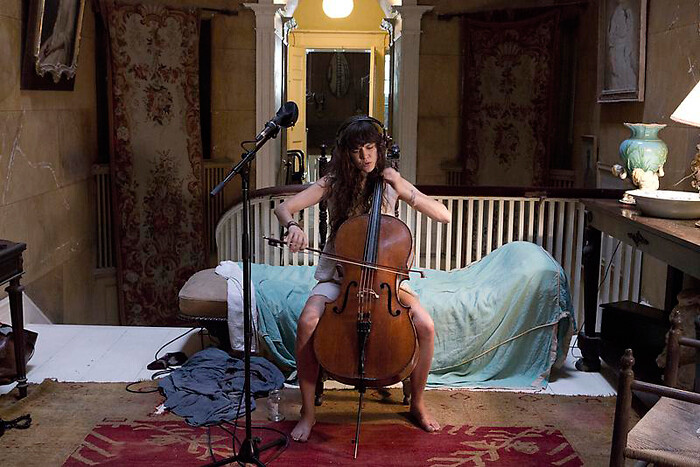Despite his radical experiments in music, modernist composer Charles Ives had the belief that America and its intellectual landscape were filled with the robust spirit of practicality. Ives liked to recall a quote from his father: “If a poet knows more about a horse than he does about heaven, he might better stick to the horse, and some day the horse may carry him into heaven.” 1
Ragnar Kjartansson has pretty much always stuck to his horse and that horse is song. The Visitors (2012) at Luhring Augustine Gallery is a nine-channel video projection detailing the communal production of a roughly hour-long folk song. The work is inspired by Swedish pop-group Abba and features lyrics from a poem by artist Ásdís Sif Gunnarsdóttir, Kjartansson’s ex-wife, with musical arrangement by the artist and Davíð Þór Jónsson. Each screen harbors one of the band members, with the artist himself playing the role of guitar-strummer and lead singer, taking a bath. The other players are reminiscent of lonesome doves—a cellist in the stairwell, a bass player in the library. Towards the end of the hour, the musicians slowly come together on the ninth screen and descend into a sublime landscape worthy of Thomas Cole’s brush (and, indeed, the setting is the Hudson River).
The music is beautiful, in a Cole kind of way—simultaneously epic and diaphanous, but also the type of music one could easily listen to on an iPod, hip. Maybe it is the case that Kjartansson is calling for a revolt against the dissonance that philosophers like Adorno have set upon aesthetics. Remember his piece God (2007), which features the artist as a 1950s TV teenage heartbreak-crooner with a backup band in a gaudy pink satin set, or the part of The End (2009) in which he plays a piano in the middle of a Canadian snow-covered tundra. Kjartansson shows some sleight of hand in these similarly stylized works—a coy reckoning of the innate attraction that people have to beauty.
The estate on which The Visitors is performed, Rokeby Farm, borrows from tropes of tradition and an appeal to consider the past. And a transcendent past it has. The Rokeby estate consists of a forty-three-room house, built in 1811 in Barrytown, New York, parked on over 400 acres of land in the Hudson River Valley. It is a well-known relic of grand wealth in the United States (railroad titan wealth), which has been slowly withering away into debilitation. Formerly occupied by some of the mightiest people in the country, its residents now count descendants, artisans, and wanderers, mostly on the lower end of the income spectrum. With a history spanning not only centuries but also highs and lows, and professionals and creatives, the estate epitomizes making the best of a slowly decaying situation. The setting certainly emphasizes Kjartansson’s attempt at making the best of a slowly decaying relationship.
But the successes of this piece’s sound and audience-friendly presentation do not equate a great artwork. At best, it functions as a somber nine-screen music video for a lyrical song. The fact that it treads closer to a music video than visual art, and that it is difficult not to divorce the perceptual experience from whatever content might be hiding within, is a possible indictment of chicanery—though that alone is not enough to nail it to a cross. An ironic hidden indication of one of Kjartansson’s weaknesses came up in an interview when the artist discussed the Venice Biennale (where he represented Iceland in 2009): “…the art was great, but somehow it disappeared within the power of the space. I thought it would be pointless to try and beat the surroundings, so my idea was to hang out in there and to be the kind of artist that I always wanted to be—a Bohemian creating paintings.” 2 Kjartansson has done a great job of simulating the Bohemian. His simulation in The Visitors is victimized by exactly the same concern he had about the Venice Biennale’s location. It is so appetizing that, even if there is a splendid statement about atrophy and human relationships, it is muddied by the physical experience of the work. As Ives would have it, an artist ought to be integral about what they are doing. A keen eye and good sense for what is “hip” will only take the horse so far—getting to heaven begs the question of why one belongs there at all.
Charles Ives, Memos, ed. John Kirkpatrick (New York: W.W. Norton, 1971) p. 240.
Elīna Zuzāne and Ragnar Kjartansson, “The Storyteller of Performances,” Arterritory. April 23, 2012, http://www.arterritory.com/en/texts/interviews/1053-the_storyteller_of_performances/.









